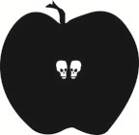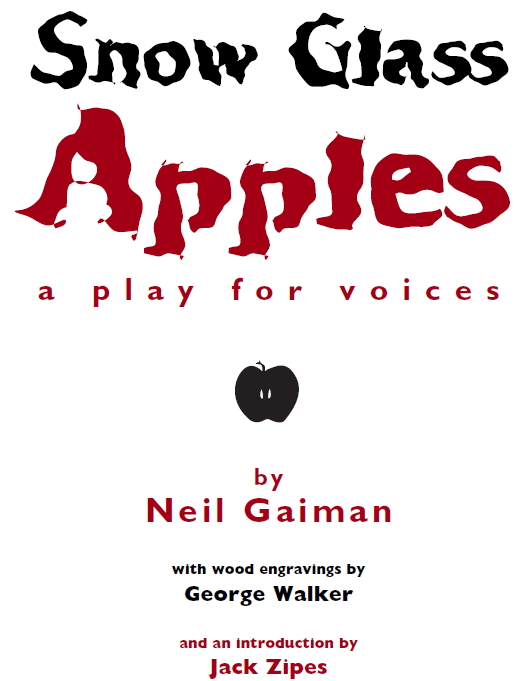Snow Glass Apples: A Play For Voices


by Neil Gaiman

Smashwords Edition
Biting Dog Publications
Duluth, Georgia
2011
— | — | —
Snow Glass Apples copyright by Neil
Gaiman
Artwork copyright by George Walker
This digital edition copyright 2011 by Biting
Dog Press
For performance rights requests please
contact
Merrilee Heifetz of Writers House at
[email protected]
Published in the United States by
Biting Dog Publications
2150 Northmont Pkwy, Suite H
Duluth, GA 30096
Thank you for purchasing a Biting Dog
Press eBook. The eBook you are reading has been revised from our
limited edition printed book. Not all of the formatting, typography
and design can be migrated to an eBook format. Although we have
made every attempt to bring you the best possible eBook experience,
there is always room for improvement. If you are not completely
satisfied with your eBook please contact us through our website
at
www.bitingdogpress.com
so that we may address any issues or concerns you may
have.

All rights reserved. No part of this
publication may be reproduced in any form or by any means
mechanical, electronic, or otherwise, without first obtaining the
written permission of the publisher, except by a reviewer who
wishes to quote brief passages in connection with a review written
for a newspaper, magazine, website, etc.
This eBook is licensed for your personal
enjoyment only. This eBook may not be re-sold or given away to
other people. If you would like to share this book with another
person, please purchase an additional copy for each person you
share it with. If you’re reading this book and did not purchase it,
or it was not purchased for your use only, then please return to
Smashwords.com and purchase your own copy. Thank you for respecting
the hard work of this author.


There are hundreds if not thousands of
versions of “Snow White” tales, collected in Europe, Asia, Africa,
and North and South America, but the one we remember most and
cherish most is the Disney film version Snow White and the Seven
Dwarfs. Perhaps cherish is the wrong word, but the virginal,
graceful and modest Snow White, who has a figure like a Barbie
Doll, who chirps when she speaks, and who is as meek as a deer, has
warmed the hearts of children and adults throughout the world ever
since the film appeared in 1937.
But what if Snow White were really a
monster?
This is the question Neil Gaiman asks in his
chilling play,
Snow Glass Apples
. He is not the only one to
ask disturbing questions about the true story behind the Disney
version we all know. Such gifted contemporary writers as Robert
Coover, Tanith Lee, and Emma Donoghue among others have also
written unsettling versions of “Snow White” that have explored the
raw sexuality of a tale concerned with the flowering of a young
girl and the crazed jealousy of her (step)mother. In fact, step
must be placed in parenthesis because not all the tales are about a
stepmother’s jealousy, as the Brothers Grimm and Disney would have
us believe. There are just as many mothers who want to kill their
own daughters as there are stepmothers who have murder on their
minds, and storytellers and writers from antiquity to the present
have spun those Snow White tales to try to understand what makes
murderous mothers tick. Sandra Gilbert and Susan Gilbert in their
famous feminist study,
The Madwoman in the Attic
, suggest
that the classical Grimm tale is all about the angel-woman and
monster-woman, who are locked in a struggle for the favor of the
absent father, represented by the mirror that frames their lives.
Their conflict is essentially a vicious cycle in which no woman can
be the winner in the patriarchal order of things, for Snow White
will also get old one day, and her beauty and position will be
challenged by her daughter or another young woman. Her triumph at
the end, as the cynical poet Anne Sexton suggests in her superb
book,
Transformations
, is a sentence of doom. She will hold
court, roll her china-blue doll eyes, and glance at herself in the
mirror until she, too, turns mad.
Gaiman’s play shifts the center of this
vicious conflict in a brilliant and inventive way. Told from the
perspective of a gullible and good-hearted stepmother, Gaiman’s
version of “Snow White” focuses on the bad seed, the indelible evil
nature of a young girl, who consumes everything and everyone near
her—her father, the inhabitants of the woods, her stepmother.
Nobody is safe from her bloodthirsty actions. So it would seem.
There is a marvelous ambivalent quality to Gaiman’s narrative. We
must ask whether the stepmother, about to be cooked, is telling the
truth. Has she concocted this story to cast blame on Snow White and
to exonerate herself from the acts that she may have committed as a
witch? We never hear Snow White’s version or anyone else’s story
about the events that led to the stepmother’s punishment. Could the
stepmother have poisoned her husband to gain power? Has she been
imagining things? After all there are cases each year in America of
delusional mothers (and fathers) who murder their own children and
twist tales to make themselves appear innocent. Then again, perhaps
the stepmother is not hysterical. Perhaps she is not lying, and her
story is especially frightening for us because it reveals something
about the ruthless power of children today and the violence with
which we all must contend.
Gaiman’s play, based on a short story that he
published in 1994, is in truth about the contemporary world despite
the timeless fairy-tale setting. We are living at a time—and it may
not have been much different several centuries ago— when it is not
uncommon for children to murder their parents or step parents, and
when child abuse keeps rising. Moreover, we are witnessing,
especially in America, children using guns on other children and
teachers in schools or on the streets. There are also incidents of
youngsters haphazardly hacking unsuspecting people to death for
their credit cards, possessions, or some small amount of money.
Very little remorse is shown. In fact, feelings or compassion for
the victims appear to be absent.
Perhaps I am reading too much into Gaiman’s
play, but I cannot help but asking why he has rewritten the
traditional “
Snow White
” tale to depict a young girl as a
monstrosity, as an unremorseful vampire. Is he asking whether the
young today have become parasitical and destructive, and if so, who
is to blame?
Yes, who is to blame for the situation in his
play? Who is to blame for the many violent acts that young people
are committing in American society? Why all the mutilation and
self-mutilation? Are we giving birth to monsters? Why do the father
and the stepmother appear to be so helpless? Gaiman does not
provide any easy answers. His Snow White appears to be cruel and
sadistic, but we are not certain whether she was born this way, or
whether her early traumatic experience of her mother’s death has
driven her to suck the blood from the world that produced and
“abandoned” her. The father has absolutely no control over his
daughter. Only the stepmother, through her use of black magic, can
contain her for a while. In the end, however, the girl triumphs
over her. But is it a triumph? Is a world that will be ruled by a
cold-blooded killer a happy kingdom? Will Gaiman’s killer Snow
White reproduce a daughter even more fierce and ruthless than her
mother?
This exquisite reproduction of Gaiman’s play
by Biting Dog Press is particularly artful and appropriate in the
manner in which it brings out the key disturbing questions of the
story through unusual design, typography, and images. George
Walker’s wood engravings are haunting and capture the mood of the
play. The indelible traces of torment and a world gone awry can be
scanned in his illustrations and throughout the entire conception
of this unusual book. After reading Gaiman’s
Snow Glass
Apples
, nobody will ever be able to view Disney’s Snow White
and the Seven Dwarfs and recall it with a happy heart. There is
another story to be told about Snow White, and Gaiman has told it
well.
Professor Jack Zipes
Department of German
205 Folwell Hall
9 Pleasant Street S. E.
Minneapolis, MN 55455
